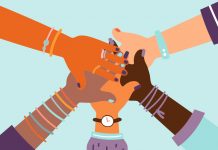What if the coronavirus is here to teach us something?
I get it, that sounds insane. At this very moment, it’s practically absurd. But, hear me out.
Our world is disconnected.
Maybe intentionally because people have some ideas that we’re safer, more protected, and, in general, we’ll be more prosperous by protecting our territory from foreigners.
Maybe our world is disconnected unintentionally– you know, as the saying goes, out of sight, out of mind.
Whatever the reason, we now have an opportunity to see each other as COVID-19 sees us: equally and connected. We have an even greater opportunity to see ourselves as global citizens and have conversations with our children about seeing the world as one world and all people equal!
Use simple language to explain the difference between social distance and segregation.
Before diving into the list below, I think it’s important to talk with our children about the differences between social distance and segregation. As we’re talking about the importance of a connected world, it may seem contrary to what we’re currently living and experiencing.
Social Distance: When we limit the amount of people that we are around. The reason that we’re practicing social distancing right now is to keep us healthy and to keep other people healthy.
Segregation: When a group of people are separated from another group of people. This is often because of how they look or what they believe.
When you’re talking with your kids about those two words, invite them to explore the similarities and differences and encourage your children to express their initial feelings about each.
Here are some actionable steps we can practice with our children, now and going forward:
- Educate ourselves with geographical locations of countries. Try starting big and working your way down (e.g. earth > continents > countries). When you begin, use the vocabulary “one world” and end with the same wordage “one world.”
- Talk about some of the simple differences between countries. This could include currency, language, and foods.
- Talk about some of the simple similarities between countries. This could include communities, human needs, emotions, and feelings.
- Make it a priority to learn about what’s going on around the world. Take time to learn about different challenges and opportunities. As parents, we can streamline this language and context into bite-sized insight for our children.
- Think, genuinely think: which ways can we contribute? Is it with time, talent, or treasure? Brainstorm with kiddos on topics from supporting communities to the environment. Keep this very simple in the beginning!
- Watch a foreign film with subtitles and eat associated cuisine. Or, watch a favorite Disney movie in a different language. You’d be surprised how fun this is for kids!
- Spend time identifying our own biases, because we all have them. If we do this as parents, it will help shape our language and emotions that we model to our children.
- Read trusted worldly content. Listen to trusted worldly podcasts. The Economist has a daily three-minute podcast.
- Talk with friends about how we’re making an effort to be more intentionally involved in our world. Encourage your children to have these conversations with their friends.
- Identify who we are. For example: what’s our race, religion, background, and culture? We must understand that before we can truly identify with other people in this world.
COVID-19 won’t be here forever. But, for now, COVID-19 is here, loves us all equally, and is eager to wrap its arms around us.
How about if we wrap our arms around knowledge and each other first? Metaphorically, of course.
What are some of the ways you help your child connect to the world? Share with us in the comments!
This is a modified excerpt from the article “10 Ways the Coronavirus Can Bring us Together, Now & After” published in Elephant Journal on March 17, 2020 by Kimberly Wyman. To read the full article click here.












Great ideas! Thanks for sharing!